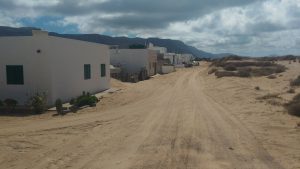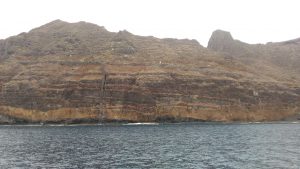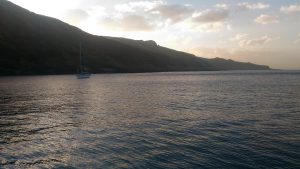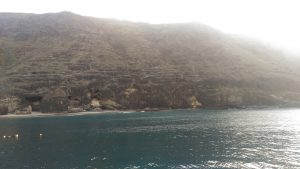“It was the best anchorage of the entire trip!” This is how Vincent described Isla Graciosa. Vincent is the man who sold us our boat. He was her second owner and did a cross-Atlantic trip on her with his family. He travelled to the Canary Islands, Senegal, Cabo Verde, the Caribbean, up to New York city and then back to France via the Northern route. After having visited so many exotic countries and stayed in so many beautiful anchorages, to boast Isla Graciosa as the best was to raise expectations.
Isla Graciosa is a small island north of Lanzarote. The entire island is part of the Parque Natural del Archipiélago Chinijo. As the island is both very small and a protected area, there is only one anchorage in front of the Playa Francesa. When a mariner talks of the anchorage at the Isla Graciosa, he is referring to this precise spot. Boats need permission to anchor here and as we are dutiful mariners who respect our host countries and marine life, we filled in the required form and sent it to the indicated email address 10 days prior to arriving, as recommended. Then we waited for a response that never came. After 5 days at sea crossing over from Gibraltar, we were not very inspired to look for another spot to land so we moored at Isla Graciosa without permission.
My thought upon arrival was, “This is it? This is the best anchorage of an entire cross-Atlantic trip?” Of course, it is beautiful. The bay gives onto the white sand beach. Short conic mountains of hues ranging from orange to black are scattered on the small island. The anchorage is surmounted by the impressive dark slat of rock that forms the cliff to the North of Lanzarote, offering a natural mirador over the Atlantic sea. And yet, I was disappointed. Our stay increased my disappointment. La Sociedad, the small fishing village that houses a port where the ferries from Lanzarote land, is a lifeless, desolate little place. The 7 roads of the village are of dirt, a sandy dirt that quicks up dust when the wind blows. The beach at Playa Francesa was scattered with rocks, which made landing on it with a dinghy a bit more complicated than desired. And frankly, after 4 days at sea and then a few days in a lonely anchorage, I was bored out of my mind. The 20 other boats moored at Graciosa where occupied by folks who were friendly but not sociable. The questions, “What am I doing with my life? What am I doing sailing around like this?” started to harass my mind. I was very happy when we lifted the anchor and headed towards Puerto Calero with the plan of visiting Lanzarote.




So far, the anchorage that I particularly liked was at the Bahai de Antequera, on the island of Tenerife. We left Lanzarote for Tenerife on the 20th of October, bypassing Fuerteventura and Cran Canaria. We travelled by night so landed at Antequera the next day at noon. So there was a bit of swell. So we had some trouble anchoring on the very firm sea floor. So there were a lot of day boats come from nearby Santa Cruz, the capital of Tenerife. So there were oil tankers out at a distance, stationed in front of the Santa Cruz port. Still, once the anchor was firmly set, I sat down in the cockpit and thought, or felt, “I like it here. I can stay here.” It was as if my being just fell into place. The bay of Antequera has a short beach of black sand and is surrounded by cliffs composed of layers of lava of various hues of gray, orange, red and yellow. To the south of the bay there is a chute of black lava that looks like a dark waterfall encrusted in the rock wall. The cliff raises into peaks that are covered with tufts of short green shrubs. Hikers make their way down from on of the peaks and camp for a night on the beach. A taxi-dinghy from Santa Cruz picks them up the next day. There are 2 small houses that look out onto the bay. They’re inhabited, though they might be squats. One of the houses, in the evening, lights a neon sign and plays music. This is the anchorage I like.




And this brings to the Baia Baixo da Rocha, south of Porto do Tarrafal on the island of Sao Nicolau. So far, it seems to be Pierrick’s favorite anchorage. We landed here yesterday after a hearty night at sea. We left Boavista the day before in the evening with good winds but waves coming against us and crashing over the deck and into the hulls. The next morning we found the dried carcass of 6 flying fish on the deck and in the trampoline. It was a tiring crossing. I hardly slept, so I went to nap as soon as we were anchored while everybody else went out to explore. Pierrick came back later in the afternoon with “a piece of paradise” on his lips. According to him, this place is second only to Cala Coves, in Minorca. We are alone here with Lucky 4 (Domnique & Zeyno’s boat) and a fishing cage that belongs to some Tarrafal fishermen. The water is crystalline. Light brown sand forms a small beach that is towered over by peaks of rocks and shrubs. Before landing onto the beach, the sides of the peaks break off into vertical sheets of gray basalt – perfect for climbing! The Monte Gordo, the highest mountain of the island, lies to the north, its tip surrounded by puffs of clouds.
Internet connection has been very good throughout Cape Verde except for here, so we’ve been spending our time holidaying: swimming, snorkeling, fishing, climbing and generally taking in this beautiful place. Apparently the sand here is rich in titanium, good for the articulations and rheumatism, so I gave myself a spa day with a sand scrub!






Baia Baixo da Rocha, Sao Nicalau.
C’est dommage, les photos ne rendent pas bien hommage aux différents lieux !
Mais je m’en étais déjà aperçue avec celles que j’ai fait à Minorque, c’est difficile de bien rendre les paysages vu du bateau.
Si j’en juge seulement par les images, Cala Coves est quand même au dessus … 🙂